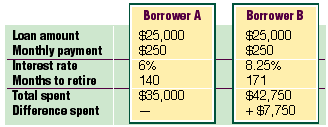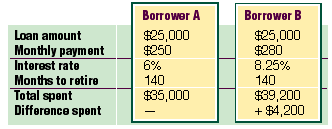
HOT TOPICS LIST
- Strategies
- Stocks
- Buy
- Investing
- Brokers
- Psychology
- Interviews
- Accumulate
- Sell
- Hold
- Spotlight
- Websites
- Candlestick Corner
- Gold & Metals
- Options Trading
LIST OF TOPICS
MONEY MANAGEMENT
Attention, Students! Lighten Your Loan Load!
08/22/01 04:19:29 PM PSTby David Penn
Still paying off those student loans? Rates for refinancing student debt through loan consolidation are at historic lows. Here's how you can do it, too.
While homeowners watch and wait for Federal Reserve Board interest cuts to put downward pressure on mortgage rates, another group of borrowers is also looking closely at declining interest rates: the millions of Americans with outstanding student loan debt totaling hundreds of billions of dollars. As interest rates for student loans fall, refinancing outstanding student loans through a process called loan consolidation becomes all the more attractive to borrowers. "If you're going to carry debt," observes Ryan Katz, managing director of the Student Loan Consolidation Center, a company that facilitates the processing of federal consolidation loan applications, "you're just going to carry it in different places. People have mortgages, people have credit cards, people have auto loans and student loans. And if you can carry debt at 6%, you should carry debt at 6% for the rest of your life if you're going to carry any debt at all." And 6% is precisely what is being offered to student loan borrowers who choose to consolidate their federal student loans right now. Through the joyous combination of low interest rates and the magic of the marketplace, all-time low rates for student loan borrowers are at hand. Says Katz: "There's over $250 billion in outstanding student loan debt in this country alone. And there's over 16 million people who have outstanding student loans. And there is almost exactly $50 billion in new loan originations annually." Added up, he continues, these numbers mean that fully 5% of the US population has outstanding student loan debt, making news of dramatic loan rate reductions very good news for many. This includes everyone from students who have just graduated to former students who have been dutifully, if laboriously, paying down their student loans for years.
COMING INTO CONSOLIDATIONLoan consolidation provides student loan borrowers with the ability to simplify the administrative task of paying multiple loan notes each month. But the vast majority of those who consolidate their student loans do so for debt relief the option of paying lower monthly loan amounts over an extended term. For many students emerging from college or graduate school, the six-month grace period after graduation hardly provides enough time for them to find a job that will enable them to repay what can be as much as $1,000 in student loan bills each month. Says Katz of many student loan borrowers: "They get out of school. They're still looking for that job that's going to help them pay down that student loan debt. But a lot of people get out of school with $50,000, $60,000, even $120,000 in debt if you're going to be a doctor. And they just can't pay a few thousand a month." While loan consolidation does mean that borrowers will end up paying more than they would have if they had not consolidated their loans, it can still be a godsend for recent graduates struggling to establish a foothold in the work world. Loan consolidation also allows borrowers to convert their variable loan rates to fixed ones. While this may not have been much of a bonus when interest rates were higher in the early and mid-1990s, today's low interest rates provide an excellent opportunity for borrowers to consolidate their student loans at the new low rates, rates that represent historic lows in the student loan industry. How low? Currently, the new rates for consolidated student loans are anticipated to drop to between 5.5% and 6.9% for qualifying student loan borrowers.
WHO BENEFITS?Who benefits from the new rates? "Basically, anyone who has federal student loan debt of greater than $10,000 is eligible," Katz points out. This means that everyone from recent graduates to those who have been repaying their student loans for five or 10 years can take advantage of historically low loan consolidation costs. As long as borrowers have at least $10,000 or more in outstanding federal student loan debt, they qualify. In fact, the only ones who don't benefit from the new consolidation rates are student loan borrowers who have already consolidated their federal student loans, many of whom were stuck with fixed rates in the neighborhood of 8%. Even those who are reluctant to extend their repayment term as is customary in student loan consolidation should find the new rates incentive enough to consolidate their loans. "You can keep your term the same," says Katz. "You can pay it off under the same term you have now, but what you are assuring yourself is that if
Who else benefits? The student loan industry, which views these lower rates as another ally in their campaign to keep student loan defaults to a minimum. Katz suggests that the student loan industry has significantly improved what he calls "their default prevention techniques" so much so that "most four-year colleges and universities fall well under 20% [defaults]." Schools begin to incur penalties when their default rates rise above 20% penalties that often include a loss of eligibility for some loan programs. Currently, the national default rate is less than 7% down from a peak of 22% in 1990. Adds Katz: "It goes without saying that if you can lower the monthly payment, then you can lower the likelihood of default and that's the reason they created this loan consolidation program in the first place. It gives borrowers the opportunity to lower their payment by up to 50% on a monthly basis." But, he warns: "One thing that is true about student loans that is not true about any other type of debt is that if you default on a student loan, that's like suicide to your credit. You can't even get rid of student loans in a bankruptcy." In comparison to other types of debt, Katz sums up, "I'd say it's very important, probably more important to make sure your student loans are being paid off."
LOW RATES? THANK THE BONDSWhile Katz says he would love to take credit for convincing the Department of Education to lower repayment interest rates for student loans, he points out that the real hero in this case is the marketplace itself. Because the interest rates on student consolidation loans are based on the yield of Treasury bills, what Katz calls "unprecedented low" T-bill yields are driving student loan rates down. "The underlying index on these loans to determine the rates is the 91-day T-bill," he explains. "Basically, they take a snapshot once a year and say this is the effective rate for the next 12 months. Then they do it again 12 months later. This year, the T-bill was at 3.69%, which gives you an underlying payback rate of 5.99% because they do the 91-day T-bill plus 2.3%. And last year, it happened to be 2.2% higher when they took that snapshot." Last year the Stafford loan, which is 90-95% of the market for federal student loans for undergraduates and graduates, had an effective rate of 8.19%. This year, it's 5.99%. Adds Katz, "it's just a huge opportunity to lock in that rate." Over the life of a 10- to 20-year repayment span, the savings of 2.2% in interest payments adds up. A $25,000 student loan at the previous consolidation interest rate of 8.19% would cost a borrower thousands more than the same student loan financed at 6.9% or 5.5%. The Student Loan Consolidation Center has estimated that consolidating loans and taking advantage of the lower rate could save borrowers between 40% and 50% in monthly payments. This saving in monthly payment can go a long way toward increasing cash flow and, more important, lowering debt to cash flow a ratio that can be important when looking to add debt through a major purchase such as a car or home. "Every lender has its own lending criteria, but I know that one issue for most people is debt to income ratio basically how much cash flow do you have available to service this debt, this auto loan, this mortgage," Katz says. "If you're paying $1,000 a month in student loans and you can lessen that burden to $500 a month through the consolidation loan, that would free up more cash and make you eligible for things you were not previously eligible for." To find out more about student loan consolidation, you can contact your school's financial aid office, your student loan lender, the US Department of Education's Office of Student Financial Assistance Programs (http://loanconsolidation.ed.gov or or 1 800 557-7392), or Katz's Student Loan Consolidation Center (http://www.slccloans.com or 1 888 800-1584).
Staff Writer David Penn may be reached at DPenn@Traders.com.
Current and past articles from Working Money, The Investors' Magazine, can be found at Working-Money.com.
Lighten Your Loan Load
Two outstanding student loans for the same amount can spell dramatic differences when varying interest rates are factored into repayment. Consider:
In this case, a difference of 2.25% means that the borrower paying the higher interest rate will in fact pay over $7,000 more than the borrower with the lower interest rate. Now let's consider the same situation, only this time borrower B decides to increase the monthly amount in order to retire the debt in the same amount of time as borrower A.
The difference still exists, but it is much smaller than before, now that the monthly payments for borrower B have increased. --D.P. |
Technical Writer for Technical Analysis of STOCKS & COMMODITIES magazine, Working-Money.com, and Traders.com Advantage.
| Title: | Traders.com Technical Writer |
| Company: | Technical Analysis, Inc. |
| Address: | 4757 California Avenue SW |
| Seattle, WA 98116 | |
| Phone # for sales: | 206 938 0570 |
| Fax: | 206 938 1307 |
| Website: | www.traders.com |
| E-mail address: | DPenn@traders.com |
Traders' Resource Links | |
| Charting the Stock Market: The Wyckoff Method -- Books | |
| Working-Money.com -- Online Trading Services | |
| Traders.com Advantage -- Online Trading Services | |
| Technical Analysis of Stocks & Commodities -- Publications and Newsletters | |
| Working Money, at Working-Money.com -- Publications and Newsletters | |
| Traders.com Advantage -- Publications and Newsletters | |
| Professional Traders Starter Kit -- Software | |
PRINT THIS ARTICLE

|

Request Information From Our Sponsors
- StockCharts.com, Inc.
- Candle Patterns
- Candlestick Charting Explained
- Intermarket Technical Analysis
- John Murphy on Chart Analysis
- John Murphy's Chart Pattern Recognition
- John Murphy's Market Message
- MurphyExplainsMarketAnalysis-Intermarket Analysis
- MurphyExplainsMarketAnalysis-Visual Analysis
- StockCharts.com
- Technical Analysis of the Financial Markets
- The Visual Investor
- VectorVest, Inc.
- Executive Premier Workshop
- One-Day Options Course
- OptionsPro
- Retirement Income Workshop
- Sure-Fire Trading Systems (VectorVest, Inc.)
- Trading as a Business Workshop
- VectorVest 7 EOD
- VectorVest 7 RealTime/IntraDay
- VectorVest AutoTester
- VectorVest Educational Services
- VectorVest OnLine
- VectorVest Options Analyzer
- VectorVest ProGraphics v6.0
- VectorVest ProTrader 7
- VectorVest RealTime Derby Tool
- VectorVest Simulator
- VectorVest Variator
- VectorVest Watchdog


